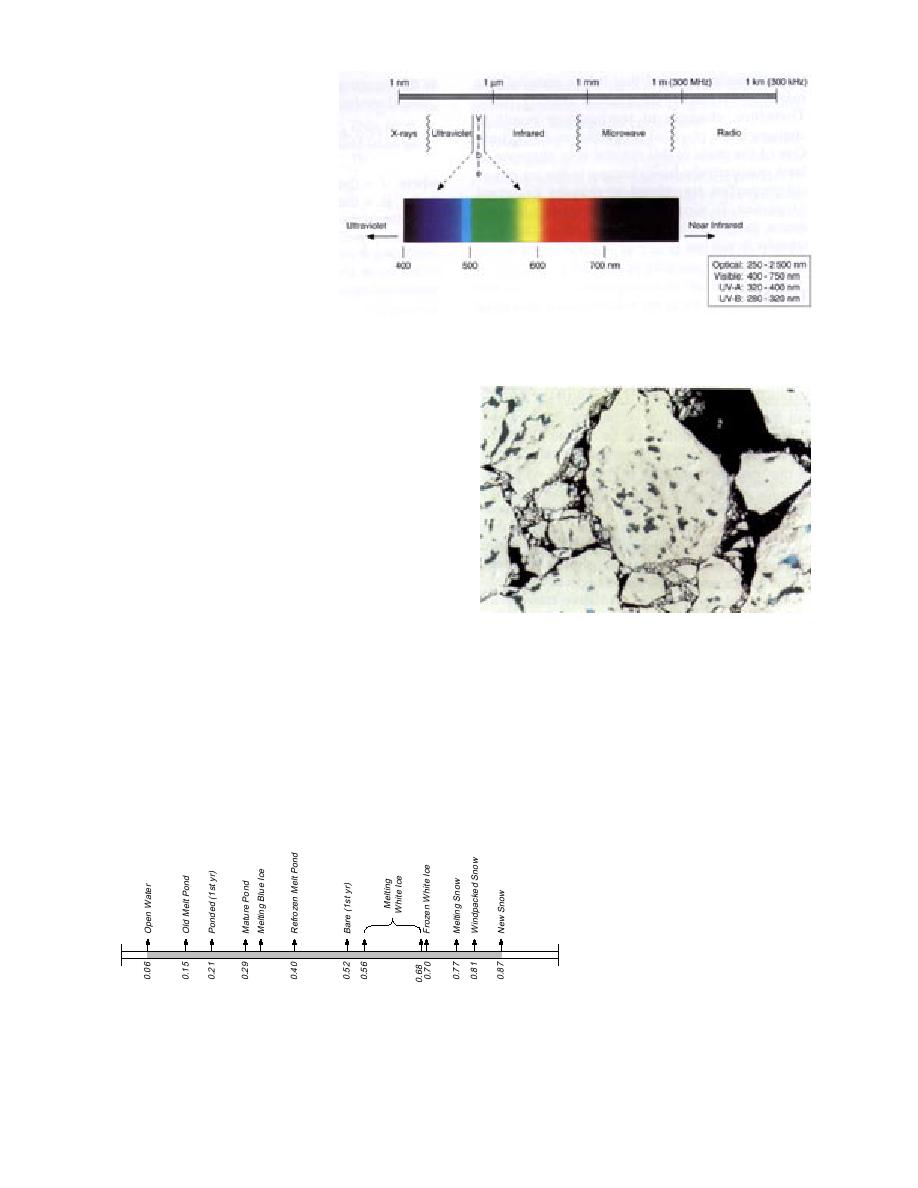
mining the optical properties of
sea ice by posing a simply stated
question: "What is the albedo of
sea ice?" Albedos are straight-
forward to determine. A radi-
ometer is used to measure the
irradiance incident on a surface
and reflected from the surface.
The albedo is constrained to lie
between 0, if none of the inci-
dent irradiance is reflected, and
1, if all the incident is reflected.
At first glance this appears to be
an easy question to answer.
Figure 1. The optical portion of the electromagnetic spectrum. Visible light is
Figure 2 is an aerial photo-
from 400 nm (violet) to 750 nm (red).
graph of a small, roughly one-
quarter-square-kilometer, area of
a typical summer Arctic scene. The melt season
has begun and there is a tremendous amount of
spatial variability in ice surface conditions: snow-
covered ice, bare white ice, blue melt ponds,
dirty ice, and areas of open water. This vari-
ability is also manifested in the wavelength-
integrated albedo, which ranges from 0.05 for
open water, to 0.2 to 0.4 for ponded ice, to 0.5
to 0.7 for bare ice, to 0.75 to 0.85 for snow-
covered ice. Observations of wavelength-inte-
grated albedo for a full range of sea ice types
and conditions are summarized in Figure 3.
Considerable variability in albedo is apparent.
Determining that the albedo falls between 0.05
Figure 2. Aerial photograph of typical Arctic summer
and 0.9 still does not provide an adequate an-
scene taken from an altitude of 600 m on 3 August
swer to our question of "What is the albedo of
1994 at 78N, 177W. The horizontal extent is approx-
sea ice?" Indeed, while the question is simple
imately 425 m.
to state, it is extremely difficult to answer on a
large scale.
of the ice. As Figure 2 indicates, sea ice exhibits a
Considering the complicated and variable
great degree of horizontal variability with diverse
physical structure of sea ice, variability in the
surface conditions, including ponds, bare ice, and
optical properties should not be surprising. To
snow-covered ice, and thicknesses that range from
understand and explain this variability, it is neces-
open water to pressure ridges over 10 m thick.
sary to examine the physical state and structure
There is also vertical complexity,
Bulk Albedo
with ice properties such as tem-
perature, salinity, brine volume
and air volume changing signifi-
cantly from the ice surface to the
ice/water interface. The details of
sea ice physical properties and
structure are summarized in
Weeks and Ackley (1982). What is
0
1.00
most germane to optics is that sea
Figure 3. Range of observed values of total albedo for sea ice. The albedos ice has an intricate structure con-
are from Burt (1954), Chernigovskiy (1963), Langleben (1971), Grenfell sisting of an ice matrix with in-
and Maykut (1977), and Grenfell and Perovich (1984).
clusions of air, brine, solid salts
3



 Previous Page
Previous Page
